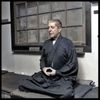18.4.2016 | 08:42
We seem to forget that the world problem is the individual problem ...
We seem to forget that the world problem is the individual problem, that the problems of the world are created by you and me as individuals.The problems of war, starvation, exploitation, and all the other innumerable problems that confront each one of us are created by you and me, and as long as we do not understand ourselves at every level, we will maintain the rottenness of the present society.
Krishnamurti
17.4.2016 | 15:18
Gopi Krishna talar um Kundalini
15.4.2016 | 08:15
Transformation of the individual
It seems to me very important, then, to understand the total process of individuality, because it is only when the individual changes radically that there can be a fundamental revolution in society. It is always the individual, never the group or the collective, that brings about a radical change in the world, and this again is historically so. Now, can the individual, that is, you and I, change radically? This transformation of the individual but not according to a pattern- is what we are concerned with, and to me it is the highest form of education. It is this transformation of the individual that constitutes religion, not the mere acceptance of a dogma, a belief, which is not religion at all. The mind that is conditioned to a particular pattern which it calls religion, whether Hindu, Christian, Buddhist, or what you will, is not a religious mind, however much it may practice all the so-called religious ideals.
Krishnamurti, Collected Works, Vol. IX ,226,Social Responsibility
14.4.2016 | 14:57
2,700 Year Old Yogi Found in Indus Valley Civilization

The 2,700 year old skeletal remains of an ancient yogi sitting in samadhi have been found in an Indus valley civilization archaeological site located at Balathal, Rajasthan.
Many Indus Valley seals depict pictures of yogis sitting in lotus position. Here are two examples showing ancient yogis sitting in meditation and keeping their hands on their knees as done in modern yoga meditations. If we see the skeletal remains of the yogi above, we can note that his fingers are in gyana mudra (with thumb touching index finger), resting on his knees as well.
14.4.2016 | 13:30
West Mountain Evening Talk
Muso Soseki (1275-1351)
When the Master was living at Nanzen-ji as a head priest, Gen'no Osho said to him, "For the last twenty years, ever since you finished your study in the monasteries, you have been moving from one place to another. By now you have changed the place you live more than ten times. I think this is harmful to a Zen student. It exhausts him and interferes with his practice.
"But recently I read the Sutra for the Period of the Imitative Dharma and according to that, the Buddha said, 'Students must stay at one place for no more than three months. Anyone who accused those who move on of being flighty will go to hell.' That disposed of some of my concern."
The Master answered, "It was not because of the Buddha's words that I kept moving on. I think of his enlightenment as my home, and I never left that whether I went off to the east or stayed behind in the west.
"Some people stay at one monastery for a long time but they do not always sit on the same Zen mat. Sometimes they leave it to wash their hands or faces. Sometimes they walk in the garden or climb a mountain or look out over the country.
"You might say that they too were rather frivolous. But because their minds are fixed on the one point even when they are moving around, it is not correct to say that they are somewhere else. If they can free their limited minds and play in the boundless world, there is nothing to reproach them for, is there?"
A monk said to the Master, "You are a descendent of Lin-chi Zenji, but you do not teach your students in the traditional Rinzai way. Instead you always give lectures on the sutras. Why is that?"
The Master answered, "For a Zen student, knowledge-understanding and practice-understanding must go together. Even then the student will not be able to benefit everyone until he has found the right person and the right circumstances. I am still no more than a fledgling, and my ability is only partly formed. I have not met the one teacher or found the best circumstances. So it is a mistake to be too critical of me.
"Nowadays there is a tendency among Zen followers who cannot see into themselves or into the subtle workings of Zen to memorize old saws just to keep a dialogue turning like a wheel, and sometimes they push or pull in some manner that's supposed to look like Zen. They flatter themselves that in doing things like that they are manifesting the heart of the Dharma.
"None of that amounts to anything. They're deceiving themselves. It's not hard to imitate the manners of the ancients, but it's very difficult to attain their virtue. I don't think much of those who set such store by externals and never notice their own lack of virtue."
The monk went on, "Then why do you preside over a sangha, comment on the sayings of our predecessors, and expound the sutras?"
The Master replied, "Those who do evil do it not because they want to go to hell but because of an earlier karma. I myself would not dare to aspire to the title of 'Master.' Just the same I lead a sangha only beause some remnant of virtue enacted in a former life impels me to do it. I don't wish to enjoy a retired life with my gate shut.
"And it follows, just as my arms swing when I walk, that I expound the sutras, comment on the words of the Patriarchs, and in that way allow those who do not believe in the law of cause and effect to learn that it exists, and help people who know nothing of Mahayana and Zen to learn the truth.
"Once a Zen master served tea to travelers beside the road for the purpose of sharing the Dharma with many people. My purpose is the same when I talk about the sayings and teachings of the Buddha and the Patriarchs."
The monk asked, "Many priests and laypeople nowadays believe in Zen, so why do you say that you have not had a chance to meet someone suited to you?"
The Master answered, "I don't mean that no one has Zen insight, but only that no one's view accords completely with mine."
The monk went on, "Even a dull student, though he may not attain satori, will grasp something of the Dharma if you show it to him directly. Why do you ignore someone like that?"
The Master answered, "Haven't you heard the saying 'A thousand pound bow and arrow won't hit a mouse'? The Buddha came to this world and his silent words and his long sermons have filled the sutra storehouse to overflowing. Why didn't he simply show the truth? You should consider that.
"Yuan-wu says, 'First deprive students of their preconceptions, and then they will be ready to undergo the ordinary Zen practice.' And Ta-hui says, 'Zen teachers should only preach Dharma according to their students' levels of Zen understanding.
"The Master's way of teaching, sudden as a flint spark or a flash of lightning, can be grasped only by those who are ready for it. To use Zen methods of that kind with novices would be like pulling up young shoots that have just been planted.'"
The monk continued, "Are you saying that the Buddha's teachings are really not true?"
Master replied, "All of your questions miss the point. So the answers I've been giving you can't be worth much either. I have made mud pies of words just to try to help you understand. A man once wrote to Yuan-wu, 'Please give me a koan.' Yuan-wu answered, 'I hear you have always read the Sutra on Perfect Enlightenment. My koan for you is in that.'
"Yuan-wu usually gave his students koans such as 'Mount Sumeru' and 'Chao-chou's Mu.' What kind of koan is 'Read the Sutra?' But if you understand what Yuan-wu really meant, you will see that not only the Sutra on Perfect Enlightenment but the other thousand sutras and ten thousand sayings, and even secular gossip and idle chatter, all of them without exception, are precisely the koans of the Patriarchs and the teachings of the Buddha. How dare you say that this is not true? Do you still criticize me for lecturing on the sutras and insist that I am not competent to be a Zen teacher?
"Once a master said, 'Before the days of Ma-tsu and Pai-chang teachers put much emphasis on richi (intellectual learning) and little on kikan (Zen practice).' What did he really mean? That the earlier teachers displayed nothing but intellectual understanding because they were without true insight? Or that those of later times lacked insight and so guided their students form the point of view of practice only, contradicting their predecessors?
"The teachings of the Patriarchs, as you know, are very different from the elucidations of Buddhist scholars, who never get further than 'one foot is one foot and two feet are two feet.' To be able to make one's actions really accord with circumstances, watching the movements of the opponent and breaking through them, this is the meaning of the well known Zen phrase, 'family broken up, house ruined.'
"Today people divide up into two groups, those who believe in practice and those who put their trust in intellectual understanding, but neither of them has gotten out of the scholars' gate. The Buddha said, 'From my first sermon at Deer Park to my last one by the Hiranyavati River I have not preached a single word.' If you can see what he meant by that you may praise or abuse me as you please."
Muso Soseki (1275-1351)
excerpted from Sun at Midnight – Poems and Sermons of Muso Soseki Trans by W. S. Merwin and Soiku Shigematsu 1989
12.4.2016 | 09:18
Paramahansa Yogananda’s SRF Lessons for Home Study
The Self-Realization Fellowship Lessons are unique among Paramahansa Yogananda’s published writings in that they give his step-by-step instructions in the yoga techniques of meditation, concentration, and energization that he taught, including Kriya Yoga.
The goal of these simple yet highly effective yoga techniques is to teach you to deal directly with energy and consciousness enabling you to recharge your body with energy, to awaken the mind's unlimited power, and to experience a deepening awareness of the Divine in your life.
The Lessons were compiled under Paramahansa Yogananda’s direction from his writings and the many classes and lectures he gave. In addition to his comprehensive instructions in meditation, the Lessons offer practical guidance for every aspect of spiritual living — how to live joyfully and successfully amidst the unceasing challenges and opportunities in this world of change.
Each lesson is 6–8 pages in length, and is meant to be studied for one week. The entire course of Lessons lasts about 3˝ years.
Topics Include:
|
Meditation Techniques Offered to Followers of All Religions
Since Yoga is based on practice and experience rather than on adherence to a particular set of beliefs, followers of all religions can benefit from the spiritual teachings in the Lessons and the three basic techniques. When practiced regularly, these methods lead unfailingly to deeper levels of spiritual awareness and perception.
Kriya Yoga
After a preliminary period of study and practice of the basic techniques, students are eligible to apply for initiation in Kriya Yoga. At this time they formally establish the sacred guru-disciple relationship with Paramahansa Yogananda and his lineage of gurus.
The technique of Kriya Yoga is given in person at special initiation ceremonies, as well as sent to each initiate in a special series of printed lessons that cover every aspect of the Kriya science.
Personal Guidance and Other Services to Students
 Lessonsstudents can also receive personal guidance in their practice at any time, free of charge, from experienced meditation counselors of the Self-Realization Fellowship Monastic Order, by contacting the International Headquarters.
Lessonsstudents can also receive personal guidance in their practice at any time, free of charge, from experienced meditation counselors of the Self-Realization Fellowship Monastic Order, by contacting the International Headquarters.
In addition, students can attend classes on the techniques of meditation conducted periodically by SRF monastics all over the world. (These classes are open only to Lessonsstudents.)
Students also receive special letters of inspiration and encouragement from the SRF president throughout the year, as well as newsletters and other publications from Self-Realization Fellowship.
Cost and Timing
The Lessons are divided into six steps of thirty lessons each, and two lessons are mailed every other week. It takes about 3˝ years to receive all of them. All of the basic meditation techniques that are preparatory to Kriya Yoga are mailed during the first 6 months.
It was Paramahansa Yogananda's wish that the Self-Realization Fellowship Lessons be easily available to all who sincerely desire to know God. To this end, the Lessons have always been offered for only a nominal fee to help cover printing and postage costs — currently about 70 cents per lesson. Full details and subscription/mailing plans are outlined on the Lessons application form.
Please allow 4–6 weeks for your first lessons to reach you.
Lessons by e-mail are not available at this time.
![]()
“After practicing your Lessons for six months, I have found all you have taught me to be true. You have proven the existence of God to me, something I once thought impossible.”
— C.C., Vienna, Virginia.
Applying online is quick and easy. You can also pay online with your credit card. This will reduce processing time for your application. |
11.4.2016 | 10:05
Where ignorance is our master ...

7.4.2016 | 15:24
Kristin mystík - Fyrirlestur á youtube
Um bloggiđ
OM - ॐ
Fćrsluflokkar
Tenglar
Hugleiđslunámskeiđ á Íslandi
- Námskeið hjá Hugleiðslu- og friðarmiðstöðinni
- Sahaja yoga-hugleiðsla
- Hugleiðslunámskeið hjá Brahma Kumaris
- Sri Chinmoy miðstöðin á Íslandi
- Andartak.is - Kundalini jóga og hugleiðsla
- Zen-hugleiðslunámskeið
- Dharma.is - Innsæishugleiðsla
- Innhverf íhugun
Frí hugleiđslunámskeiđ á Netinu
- Free Meditations
- Námskeið í búddískri hugleiðslu
- Námskeið í Kundalini yoga
- Free online meditation course
- Free Sahaja meditation course online
Hugleiđsla
Hér er ađ finna tengla ţar sem ţú getur lćrt og kynnt ţér hugleiđslu.
- Listin að hugleiða
- Zen á Íslandi - Zen-hugleiðsla
- Kristbjörg
- Kundalini-hugleiðsla
- Hugleiðslu- og friðarmiðstöðin
- SGI-búddismi á Íslandi
- Sri Chinmoy miðstöðin á Íslandi
- Skandinavíski yoga- og hugleiðsluskólinn
- Leiðbeiningar fyrir Zen-hugleiðslu
- Sahaja Yoga
- Brahma Kumaris - Raja Yoga hugleiðsla
- Jack Kornfield - Insight Meditation (vipassana)
- Centerpointe
- Ljósmiðlun
- Traditional Yoga and Meditation of the Himalayan Masters
- Innhverf íhugun
- Vipassana meditation course
Helg forn rit
- Veda-ritin
- Bhagavad Gita
- Bhagavad Gita
- Upanishads
- Upanishads
- Shiva sutra
- Brahma Sutra
- Yogasútrur Patanjalis
- Rig Veda
- Sama Veda
- Hatha Yoga Pradipika
- Shiva Samhita
- Gheranda Samhita
- Sacred Texts (Helg indversk rit)
- Biblían
- Dhammapada
- Kóraninn
Tímarit um andleg málefni
- Tímaritið Knowledge of reality
- Bindu - Tímarit Skandinavíska yoga- og hugleiðsluskólans
- Tímaritið Gangleri
- Primary Point - Zen
- Efnisskrá Ganglera frá 1926
- The Sufism Journal online
- The Theosophist
Bćkur á íslensku um andleg málefni
- Starfsrækt (Karma yoga) - Swami Vivekananda
- Allar bækur Gunnars Dal
- Bækur eftir Alice Baily
- Martínus - Bækur á íslensku
- Launviska Vedabóka
Bćkur um andleg málefni
- The Unknown Life of Jesus Christ
- Bók um Kriya Yoga
- Sjálfsævisaga Jóga
- Whispers from Eternity - Paramahansa Yogananda
- The Path - Swami Kriyananda
- God is for Everyone - Inspired by Yogananda
- My time with the master - Paramahansa Prajnanananda
- The Universe Within - Paramahansa Prajnanananda
- The art and science of Raja Yoga - Swami Kriyananda
- Complete work of Swami Vivekananda
- Gopi Krishna - Bækur, greinar og viðtöl
- Bókin Zen and the brain
- Zen Mind, Beginner´s Mind - Shunryu Suzuki-roshi
- Manual of Zen Buddhisim - D. T. Suzuki
- Stripping the Gurus
- Rödd þagnarinnar á ensku
- Eckhart Tolle - Stillness Speaks - Hljóðbók
- Bækur eftir Ramana Maharshi
- Saundarya Lahiri
- The Meditative Mind - Krishnamurti
- Krishnamurti´s Notebook
- Meditations - Krishnamurti
- The Serpent Power
- C. W. Leadbeater - Chakras: A Monograph
- Kundalini Yoga - Swami Sivananda
- Fríar bækur með Krishnamurti
- The Tibetan Book of Dead
- Karma Yoga - Swami Vivekananda
- Leiðarljós (Light on the Path) á ensku
- The Power of Now - Hljóðbók
- Hljóðbókin Breath sweeps mind eftir Jakusho Kwong-roshi
- Opening the Hand of Thought Bók eftir Kosho Uchiyama
- To shine one corner of the world : moments with Shunryu Suzuki : stories of a Zen master told by his students
- How to Cook your Life - Dogen
- The Art of Just Sitting: Essential Writings on the Zen Practice of Shikantaza
- On Zen Practice
- On Having No Head
Greinar um andleg málefni
- Greinasafn Lífspekifélagsins/Guðspekifélagsins
- Greinar eftir Sigvalda Hjálmarsson
- Greinar og rannskóknir tengdar kundalini
- Krishnamurti - Greinar, viðtöl og tilvitnanir
- Hugleiðingar um kenningar Sigvalda Hjálmarssonar - I. Hluti
- Hugleiðingar um kenningar Sigvalda Hjálmarssonar - II. hluti
- Greinar úr zen-tímaritinu Primary Point
- Greinar eftir dr. Erlend Haraldsson
- Greinasafn Jóns L. Arnalds
- Yður er í dag frelsari fæddur? - Njörður P. Njarðvík
- Yoga og geðrækt
- Leiðin til hugljómunar - Sigvaldi Hjálmarsson
- Geinar úr tímaritinu Quest
Ýmsir tenglar andlegs eđlis - Íslenskir
- Kærleikssetrið
- Jógakennarafélag Íslands
- Lífspekifélagið/Guðspekifélagið
- AA
- CoDa
- Viska og gleði
- Kærleikssamtökin
- Björg Einarsdóttir
- Trú.is
- LAUSNIN - Baráttusamtök gegn meðvirkni
- Dharma.is - Innsæishugleiðsla
- Dulheimar - Andleg þróunarheimspeki
- Vetrarbrautin.com
- Listi yfir skráð trú- og lífskoðunarfélög á Íslandi
Ýmsir tenglar andlegs eđlis - Erlendir
- DharmaTalk með Thich Nhat Hanh
- Agni Yoga
- Meditation of the Himalayan Masters
- Vedanta Society
- Vedanta.com
- tantra-kundalini.com
- Ayurveda-próf - Hvaða líkamsgerð ertu?
- Prajnanamission
- Big Mind
- Vedanta Spiritual Library
- Great Integral Awakening
- Sounds True
- Wildmind - Buddhist Meditation
- Institute for Consciousness Research
- Biology of Kundalini
- Kundalini Research Network
- Hindu Tantrik Tradition
- Inner Self
- Spirit Voyage
- Dalai Lama kyrjar möntru úr Rig Veda
- Ýmislegt um Ramakrishna
- The Five Tibetan Rite
- Message from masters
- Bæklingur um sanskrítarframburð
- The Theosophical Society - International Headquarters
- Sri Vidya
- Vedanet
- Eastern tradition - Eastern Tradition Research Archive
- Lífspekifélög/Guðspekifélög um allan heim
Ýmsir andans menn
- Sigvaldi Hjálmarsson
- J. Krishnamurti
- Ken Wilber
- Gopi Krishna
- Swami Sivananda
- Osho
- Deepak Chopra
- Swami Vivekananda
- Sri Ramakrishna
- Yogi Hari
- Eckhart Tolle
- Yogi Shanti Desai
- Yogi Amrit Desai
- Shunryu Suzuki roshi
- Ramana Maharishi
- Sri Aurobindo
- Paramahansa Yogananda
- Paramahamsa Hariharananda
- Jakusho Kwong-roshi
- Jack Kornfield
- Swami Rama
- Grétar Fells
- D. T. Suzuki
- Dalai Lama
- Thich Nhat Hanh
- Eckhart Tolle
- Helena Blavatsky
- Paramahamsa Prajnanananda
- Rupert Spira
- Bodhidharma
- Om Swami
Lífspeki/Guđspeki
- Lífspekifélag Íslands
- Lífspekifélagið í USA
- Helena Blavatzky
- Facebook-síða Lífspekifélags Íslands
- Aðalstöðvar Lífspekifélagsins á Indlandi
Kriya Yoga
Hér er ađ finna tengla tengda Kriya Yoga
- Kriya Yoga Institute
- Paramahansa Hariharananda
- Paramahamsa Prajnanananda
- Bækur um Kriya Yoga eftir Hariharananda og Prajnananda
- Self-Realization Fellowship
- Ananda: The Teaching of Paramahansa Yogananda
- Cyberspace Ashram for Kriya Yoga
- Bókin Sjálfsævisaga jóga (Autobiography of a Yogi)
- Kriya Yoga - Swami Shankarananda Giri
- Kriya Yoga - Yogi Dhirananda
- Bók um Kriya Yoga á Netinu
- Kriya Yoga in the Lahiri Mahasaya family tradition
- Babaji´s Kriya Yoga
- Myndbönd um kriya yoga
- Prajnanamission
- Babaji Kriya Hatha Yoga - 18 Kriya Postures
- Umsókn - Kennslustundir hjá SRF
Hatha Yoga (Líkamsstöđur - Teygjur)
- Yogavin
- Jóga hjá Kristbjörgu
- Jóga Stúdíó
- Jógakennarafélag Íslands
- Jóga Jörð
- Jen Reviews
- Sólir
- Yogashala
- Jógakennarar og jógastöðvar á Íslandi
Zen
- Zen á Íslandi
- Sonoma Mountain Zen Center
- Bókin Zen Mind, Beginners Mind eftir Shunryu Suzuki-roshi
- Bókin No Beginning. No End eftir Jakusho Kwong-roshi kennara Zen á Íslandi
- Hljóðbókin Breath Sweeps Mind eftir Jakusho Kwong-roshi
- The Teaching of Shunryu Suzuki-roshi
- San Francisco Zen Center
- Myndbönd með Suzuki-roshi
- Plum Village - Thich Nhat Hanh
- Zen of Recovery - Mel Ash
- Zen Road
- Zen sútrur
- Kwan Um School of Zen
- Daily Zen
- Big Mind
- Zen Peacemakers
- Suzuki-roshi 50
- Hljóðbókin Zen mind, beginner´s mind
- The Suzuki Roshi Audio Archive
- Opening the Hand of Thought Bók eftir Kosho Uchiyama
- To shine one corner of the world : moments with Shunryu Suzuki : stories of a Zen master told by his students
- How to Cook your Life - Dogen
- The Art of Just Sitting: Essential Writings on the Zen Practice of Shikantaza
- On Zen Practice
Bloggvinir
-
 thesecret
thesecret
-
 gudjonbergmann
gudjonbergmann
-
 gyda
gyda
-
 heringi
heringi
-
 gudmundurhelgi
gudmundurhelgi
-
 braxi
braxi
-
 fruheimsmeistari
fruheimsmeistari
-
 vilborg-e
vilborg-e
-
 steina
steina
-
 ludvik
ludvik
-
 maggadora
maggadora
-
 baenamaer
baenamaer
-
 perlaheim
perlaheim
-
 vestfirdir
vestfirdir
-
 vglilja
vglilja
-
 palmig
palmig
-
 einherji
einherji
-
 andreaolafs
andreaolafs
-
 flinston
flinston
-
 birnarebekka
birnarebekka
-
 tilfinningar
tilfinningar
-
 dizadj
dizadj
-
 gylforce
gylforce
-
 esa-emorea777
esa-emorea777
-
 estersv
estersv
-
 eydis
eydis
-
 gudjonelias
gudjonelias
-
 heildraent-joga
heildraent-joga
-
 heildraent-lif
heildraent-lif
-
 guru
guru
-
 tru
tru
-
 fun
fun
-
 jensgud
jensgud
-
 josira
josira
-
 katrinsnaeholm
katrinsnaeholm
-
 kari-hardarson
kari-hardarson
-
 kiza
kiza
-
 kjarvald
kjarvald
-
 kristinnhalldor
kristinnhalldor
-
 kiddirokk
kiddirokk
-
 krilli
krilli
-
 laufherm
laufherm
-
 mariaannakristjansdottir
mariaannakristjansdottir
-
 manisvans
manisvans
-
 nanna
nanna
-
 aronsky
aronsky
-
 huldumenn
huldumenn
-
 ragjo
ragjo
-
 rose
rose
-
 straitjacket
straitjacket
-
 vinur
vinur
-
 nimbus
nimbus
-
 slembra
slembra
-
 svanurg
svanurg
-
 toshiki
toshiki
-
 hanoi
hanoi
-
 thorhallurheimisson
thorhallurheimisson
Heimsóknir
Flettingar
- Í dag (10.6.): 1
- Sl. sólarhring: 3
- Sl. viku: 22
- Frá upphafi: 96329
Annađ
- Innlit í dag: 1
- Innlit sl. viku: 21
- Gestir í dag: 1
- IP-tölur í dag: 1
Uppfćrt á 3 mín. fresti.
Skýringar









